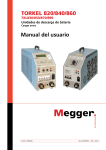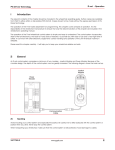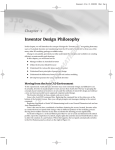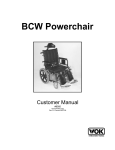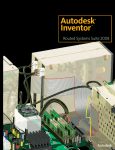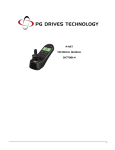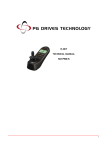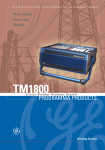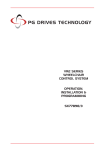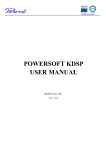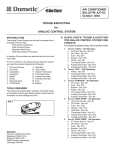Download User`s Manual
Transcript
TORKEL 820/840/860 Battery Load Units User's Manual User's manual TORKEL 820/840/860 Battery Load Units NOTICE OF COPYRIGHT & PROPRIETARY RIGHTS © 2007, Programma Electric AB. All rights reserved. The contents of this manual are the property of Programma Electric AB. No part of this work may be reproduced or transmitted in any form or by any means, except as permitted in written license agreement with Programma Electric AB. Programma Electric AB has made every reasonable attempt to ensure the completeness and accuracy of this document. However, the information contained in this manual is subject to change without notice, and does not represent a commitment on the part of Programma Electric AB. Any attached hardware schematics and technical descriptions, or software listings that disclose source code, are for informational purposes only. Reproduction in whole or in part to create working hardware or software for other than Programma Electric AB products is strictly prohibited, except as permitted by written license agreement with Programma Electric AB. TRADEMARK NOTICES Programma® is a registered trademark of Programma Electric AB. All other brand and product names mentioned in this document are trademarks or registered trademarks of their respective companies. Programma Electric AB Eldarvägen 4 Box 2970 SE-187 29 TÄBY Sweden Programma Electric AB ZP-BS06E R101 T +46 8 510 195 00 F +46 8 510 195 95 [email protected] www.programma.se 3 TORKEL 820/840/860 Contents 1 Introduction ........................................ 6 General....................................................... 6 TORKEL 820/840/860 ................................. 6 TXL830/850/870 (Extra Loads) ................... 6 TORKEL Win software (optional)................. 6 2 Safety................................................... 8 3 Menu system..................................... 10 Main menu ............................................... 10 Results ..................................................... 10 Test battery .............................................. 10 Auto-limits ............................................... 10 Memory ................................................... 10 Select language........................................ 10 Basic settings............................................ 10 Test method ............................................. 10 4 Control panel..................................... 12 1 – Operator control................................. 12 2 – External current measurement ............ 12 3 – Circuit breaker.................................... 13 4 – External control ................................. 13 5 – Mains ................................................. 13 6 – Connection terminals for the battery . 13 5 Conducting a test.............................. 14 Test at constant current............................. 14 Safety precautions .................................... 14 Preparations for testing ............................ 14 Connecting the current cables to the battery ..................................................... 14 Setting the current ................................... 15 Warning and stop limit parameters........... 15 Starting the test ....................................... 15 Pausing the test........................................ 15 Ending the test......................................... 15 6 Testing at constant power / resistance 16 Constant power........................................ 16 General..................................................... 18 Preparations.............................................. 18 Testing ...................................................... 19 Starting the test ........................................ 19 8 External current measurement ........ 20 General..................................................... 20 Applications ............................................. 20 Setting up external current measurement.. 21 TORKEL .................................................... 21 DC clamp-on ammeter ............................. 21 Connections............................................. 22 Troubleshooting ........................................ 22 9 Alarm function .................................. 24 Description ............................................... 24 Resetting the alarm .................................. 24 10 Auto-limits......................................... 26 Invoking the auto-limits function............... 26 Activating auto-limits ............................... 26 11 TORKEL connected to a PC ............... 28 General..................................................... 28 TORKEL Win program ............................... 28 TORKEL Win features .............................. 28 Installing TORKEL Win............................... 29 Installation ............................................... 29 Setting up communication ....................... 29 Loading the software key ......................... 29 Changing the language used in TORKEL... 30 Testing with TORKEL Win.......................... 30 Viewing the results ................................... 30 12 Starting and stopping from an external device..................................................... 32 Start/stop connector ................................. 32 Starting .................................................... 32 Stopping .................................................. 32 13 How to obtain the desired current.. 34 General..................................................... 34 TORKEL load capacity................................ 34 Configuring TORKEL for constant resistance ................................................. 16 Imax......................................................... 34 Max power............................................... 35 Final voltage............................................. 35 Examples of load capacities ...................... 35 7 Testing with a load profile ................ 18 When a single TORKEL isn’t enough.......... 36 Configuring TORKEL for constant power .. 16 Constant resistance ................................... 16 4 TXL Extra Loads connected to TORKEL ..... 36 Programma Electric AB ZP-BS06E R101 TORKEL 820/840/860 Calculating how many TORKELs and TXLs are needed..................................................... 36 TORKEL/TXL system examples................... 37 Test conducted using a system comprising TORKEL and TXL units ........................ 39 Hookup and settings ................................ 39 14 TXL Extra Loads ................................ 40 1 – Selector switch ................................... 40 2 – Circuit breaker.................................... 40 3 – Connection terminals for the battery . 40 4 – Control............................................... 40 5 – Mains ................................................. 40 Setting up the extra load........................... 41 Testing ...................................................... 41 15 Optional accessories ......................... 42 Cables...................................................... 42 Clamp-on DC ammeter ............................ 42 Software .................................................. 42 Other ....................................................... 42 16 Troubleshooting................................ 44 Messages on display................................. 44 17 Calibration......................................... 46 Calibration procedure ............................... 46 How to calibrate ....................................... 46 1. Calibrating zero levels........................... 46 2. Calibrating internal current................... 47 3. Calibrating internal and external voltage..................................................... 47 4. Calibrating of external current.............. 48 Resetting TORKEL ..................................... 49 General .................................................... 49 Performing a reset .................................... 49 18 Specifications .................................... 50 Torkel 820................................................. 50 Torkel 840/860.......................................... 51 TXL 830 /850 /870 .................................... 53 19 Index .................................................. 54 Programma Electric AB ZP-BS06E R101 5 TORKEL 820/840/860 1 Introduction General This manual explains how to use TORKEL 820, TORKEL 840 and TORKEL 860 Battery Load Units, and it also covers the TXL830, TXL850 and TXL870 Extra Loads. Although performance differs from one model to the next, all models are used in the same way. Unless otherwise specified, what is set forth in this manual applies to all models. TORKEL 820/840/860 These Battery Load Units are sophisticated instruments designed mainly for capacity tests. All three units can be programmed to test a battery bank at constant current, constant power, or using a user-defined load profile. TORKEL can also be used for testing battery chargers and other electrical equipment that require resistive load testing. The three models have different maximum voltage ratings: TORKEL 820 60 V DC TORKEL 840 288 V DC TORKEL 860 480 V DC TORKEL has a number of functions that facilitate its use. Examples include: TXL830/850/870 (Extra Loads) The TXL830, TXL850 and TXL870 Extra Loads comprise resistive loads. They can be used together with TORKEL Load Units to increase loading capability. The TXL Extra Loads can not provide regulatation by themselves but TORKEL measures total current from the battery and regulates the load characteristic. When TORKEL is stopped it sends a stop signal to the TXL Extra Load. The three models have different maximum voltage ratings: TXL830 28 V TXL850 56 V TXL870 280 V TORKEL Win software (optional) The TORKEL Win program, which runs on a PC under Windows®, builds up a voltage curve on the screen in real time and displays the current, voltage and capacity readings. You can also use TORKEL Win to control TORKEL during the test . The program stores the results in a text file, and it can generate reports • Warning and automatic stop functions for time, discharged capacity and low battery voltage. • 9 memories where settings can be stored. • Voltage curve can be stored for later transfer to a PC using the TORKEL Win program. • Discharging can be started/stopped from external equipment. • Testing can be carried out without disconnecting the regular load. 6 Programma Electric AB ZP-BS06E R101 TORKEL 820/840/860 Programma Electric AB ZP-BS06E R101 7 TORKEL 820/840/860 2 Safety Symbols on the instrumentI Caution, refer to accompanying documents. Caution, risk of electric shock. Hot, do not cover Protective conductor terminal. Safety instructions Warning The electrical voltage and current used in battery testing is potentially lethal. Ensure that the AC supply is isolated and any battery under test is disconnected before attempting any cleaning or maintenance of TORKEL. Do not connect or disconnect any of the cables unless the circuit breaker F1 is in the lower (OFF) position. Connection and disconnection procedures are extremely important. Be sure to follow the instructions faithfully. Do not touch conducting parts of the clamps on the current cables or the voltage sensing cables when they are connected to TORKEL. WEEE, Waste Electrical and Electronic Equipment. Please utilize your local WEEE collection facilities in the disposition of this product and otherwise observe all applicable requirements. Explosion risk when using Torkel and TXL (all models) When a lead acid battery is charged or discharged i.e. when there is a current flow through the battery it is always a risk that the battery can explode. For new open (vented) batteries the risk is medium to low but in old VRLA (sealed) batteries the risk is medium to high. If there is a bad connection inside the battery and there is a current flow - the connection will burn off and there will be an arc, which will ignite the oxyhydrogen gas in the battery. To minimize the risk for personnel injuries: Always place Torkel/TXL as far away from the battery as possible - use long current cables and/or remote start/stop.Never stand close to a battery during charge/discharge. Too high discharge current applied on a battery can cause the battery to explode or get over-heated. Be sure to not set too high current. If the external current measurement is interrupted or giving false values during the test, the current will rise to a higher level than the set value before the test is shut down. If the battery is too small for this current or in a bad condition - it may explode. 8 Programma Electric AB ZP-BS06E R101 TORKEL 820/840/860 When using the external current measurement function: 1. Check that the CT is connected in the right current direction. 2 Always replace the CT internal battery before a test. 3 Set the correct current ratio in the external current measurement menu. Never use the TORKEL/TXL Extra Load in an explosive environment. Never put the TORKEL/TXL Extra Load where it can be reached by battery gas. Improperly connected cables carrying high current can cause fire. Make sure that the cables are not twisted in such a way that could cause them to turn and come loose from the connector. Position TORKEL/TXL Extra Load where air flow is unobstructed and where it does not come into contact with any flammable or heat-sensitive material. Keep a free distance of 1.5 m (5 ft) to the vertical sides of TORKEL/TXL and 2.0 m (6.5 ft) above TORKEL/TXL. Do not place TORKEL a) near another TORKEL, a TXL Extra Load or any other heat source or b) where the cooling airflow can be blocked. TORKEL will overheat if there is insufficient cooling. External current shunt may not be used above 300 V DC Important! Make sure that the clamp-on ammeter is properly connected and that its battery lasts throughout the entire test. If external current measurement malfunctions, TORKEL might provide a higher load current than intended. Do not use liquid detergents or aero-sols when cleaning TORKEL or TXL units. Use a damp cloth. If TORKEL has been stored below freezing for an extended period of time, you must allow 3 hours for it to adapt to room temperature. Programma Electric AB ZP-BS06E R101 9 TORKEL 820/840/860 3 Menu system Main menu When you start a profile test you will be asked for the number of steps, the test duration (time) and the load value for each step. Results Displays voltage, capacity, current and testing period (time) from the last test. Test battery Submenu used to perform a test. Auto-limits Submenu used to provide automatic calculation and setting of limit values. Here, you specify the desired voltage per cell at which a) warnings are to be issued and b) the test is to be stopped. Examples: warning at 1.85 V/cell and stop at 1.75 V/cell. Then, when you begin a test, TORKEL asks you to enter the number of cells, whereupon it calculates the voltage and sets this voltage as the limit. Memory You can save and recall the settings in any of 9 memories. Moreover, you can recall the factory (standard) settings. Select language Here, you select the language that will be used in the display. Basic settings Here, you specify whether the current is to be measured internally within TORKEL or by means of a clampon ammeter. You can also adjust TORKEL to the mV/A ratio that appears on the clamp-on ammeter itself. Test method Here you specify one of the following test methods: constant current, constant power, constant resistance, current profile or power profile. 10 Programma Electric AB ZP-BS06E R101 TORKEL 820/840/860 Programma Electric AB ZP-BS06E R101 11 TORKEL 820/840/860 4 Control panel <ENTER> key. Press to select and confirm parameters. <START> key. Press to start discharging. <STOP> key. Press to stop/pause discharging. Lamps OPERATING a) LED will glow steadily while TORKEL is discharging. b) LED will flash when the current (or power) can not be regulated to the desired value. Vmin (V) a) LED will glow steadily after TORKEL has shut down because the voltage has dropped to the stop limit. b) LED will flash when the voltage has decreased to the warning limit. I•t (Ah) a) LED will glow steadily when TORKEL has shut down because the discharged capacity has reached the stop limit. b) LED will flash when the discharged capacity has exceeded the warning limit. Time (h) a) LED will glow steadily when TORKEL has shut down after completing the preset time cycle b) LED will flash when the time has exceeded the warning limit. 0 Operator control Display Display settings during programming and measured values during operation. Keys <LIMITS> key. Press to enter the LIMITS MENU <ESC> key. Press to exit from a function without changing any data or to go backwards in the menu system. Horizontal and vertical arrow keys, . Used to select data and to change values. <SET LOAD> key. Press to change the load. 12 1 External current measurement External current measurement Input used to measure current in an external path by means of a clamp-on ammeter or a current shunt. Input impedance: 1 Mohm. Galvanically isolated. Insulation voltage to battery current terminals: 2300 V Insulation voltage to ground: 1350 V 2 Circuit breaker F1 Voltage controlled circuit breaker that connects / disconnects the loading circuits in TORKEL from the battery. Programma Electric AB ZP-BS06E R101 TORKEL 820/840/860 Note F1 will not latch in upper (ON) position until TORKEL has issued a message reading“Switch on F1”. 3 External control ALARM Output equipped with a relay contact for triggering an external alarm device Relay contact: 1 A / 100 VAC, 1 A / 50 VDC, 0.3 A / 250 VDC. This latter (250 V DC) is valid for resistive load only. Connector insulation: Voltage to ground may not exceed 250 V START/STOP Input used for starting and stopping discharging from an external device. Galvanically isolated. TXL Output used for control of TXL Extra Loads. Galvanically isolated. SERIAL Serial port used for connection to a PC or other controlling equipment. 4 Mains MAINS Connector for mains supply, equipped with ON/OFF switch. 5 Connection terminals for the battery + (Terminal) Positive (+) current connection for battery being tested. – (Terminal) Negative (-) current connection for battery being tested. Insulation voltage to ground: 2200 V VOLTAGE SENSE Input for sensing voltage at the battery terminals. Impedance to the battery current terminals is >1 Mohm. Programma Electric AB ZP-BS06E R101 13 TORKEL 820/840/860 5 Conducting a test Test at constant current Safety precautions Warning Do not connect or disconnect any of the cables unless the circuit breaker F1 is in the lower (OFF) position. Never use TORKEL/TXL Extra Load in an explosive environment. Never put TORKEL/TXL Extra Load in direct contact with battery gas. Note Press ESC if you want to access the main menu. Important Connection and disconnection procedures are extremely important. Be sure to follow the the instructions faithfully. Connecting the current cables to the battery Use the cables supplied with TORKEL or other cables of suitable size. Follow the numbered steps that are set forth below. Inspect each connection to make sure it is securely fittted. Position TORKEL/TXL Extra Load so that the air flow is unobstructed and free from contact with any flammable or heat-sensitive material. Do not place TORKEL near another TORKEL, a TXL Extra Load or any other heat source. TORKEL will overheat if there is insufficient cooling. Inspect cable connections to make sure there is no short circuit. Preparations for testing 1] Connect TORKEL to the mains voltage. 2] Switch on TORKEL. Connecting TORKEL to a battery. 1] Connect one end of the first cable to the negative (-) terminal on TORKEL. 2] Connect the other end of the first cable to the The following display will appear for a short time: TORKEL 840 R01A negative (-) pole of the battery. 3] Connect one end of the second cable to the positive (+) pole of the battery. It will then change to: MAIN MENU Test battery and then: Connect battery 14 4] Connect the other end of the second cable to the positive (+) terminal on TORKEL. Tip To get a more accurate voltage reading. Connect the voltage sensing cables between the “VOLTAGE SENSE” input on TORKEL and the battery terminals. Programma Electric AB ZP-BS06E R101 TORKEL 820/840/860 Warning Do not disconnect any of the above cables until the test is completed and the circuit breaker F1 is in the lower (OFF) position. panel flashes when the warning level is reached and starts to glow steadily if TORKEL is stopped. See also the chapter headed” Alarm function”. Limits set-up Note TORKEL automatically selects the voltage range when voltage is applied to the high-current terminals. Setting the current 1] Use the horizontal arrow keys ( or ) to select the position and the vertical arrow keys ( or ) to set the value. 1] Press <LIMITS> Warning Umin No 044.4 V 2] Use the horizontal arrow keys ( or ) to move the cursor and the vertical arrow keys ( or ) to activate the warning (Yes) and to set the voltage level. 3] Press <ENTER> Set Current 0001.0 A 4] Proceed in the same way for other parameters 2] Press <ENTER>. 5] Press <LIMITS> when you have finished setting you want to change. After connecting the battery, about 30 seconds must elapse before you can switch on the circuit breaker F1 and start the test. TORKEL displays the amount of time you must wait as follows: 1] Press <START>. When the time shown has elapsed, the following will appear: Switch on F1 Press ENTER The current value (A) will be displayed and the OPERATING lamp will light up. Pausing the test 3] Switch on F1 (press the lever upwards a second time if it fails to latch immediately). 4] Confirm by pressing <ENTER>. TORKEL now displays the values currently in effect: Tip The limits can be changed at any time during a test. Starting the test Please wait... 25 sec 51.6V 0.0 A the parameters. 0.0 Ah 0:00:00 You can change the current at any time by pressing the <SET LOAD> key. Warning and stop limit parameters 1] Press <STOP>. 2] Restart by pressing <START>. Note Any TXL Extra Loads connected to TORKEL must be restarted manually. Ending the test 1] Press the <STOP> key. 2] Press <ESC> End Test? Yes No 3] Select ”Yes” and press <ENTER>. You can set TORKEL to issue a warning and/or to stop: • When the voltage has reached a certain level. • When a certain amount of capacity is discharged. • After a specified time. The settings for the warning and stop levels are independent of each other. When a limit is reached, the contacts in the ALARM relay operate and a buzzer sounds. In addition, the lamp associated with the parameter on the control Programma Electric AB ZP-BS06E R101 15 TORKEL 820/840/860 6 Testing at constant power / resistance Constant power TORKEL can be used to conduct a discharge test at constant power instead of constant current. All procedures are the same except that you must set TORKEL differently before starting – you set the power instead of the current. Warning See the chapter "Conducting a test" for safety precautions and how to prepare the test. Important When testing at constant power, the current will increase as the voltage decreases. Calculate the current at the end of the test (W / V = A). Then make sure that the total current does not exceed 2999 A. Also make sure that the TORKEL and TXL units can provide the required current load troughout the test. Constant resistance WARNING! See the chapter "Conducting a test" for safety precautions and how to prepare the test Configuring TORKEL for constant resistance 1] Press <ESC> repeatedly until you see the ”MAIN MENU”. 2] Select ”Test method” using the vertical arrow keys ( or ) and press <ENTER>. 3] Select ”Constant R” and press <ENTER>. 4] Select ”Test battery” and press <ENTER>. 5] Set the resistance value in the same way that you set the current value. See the chapter headed “Conducting a test”. Configuring TORKEL for constant power 1] Calculate the current at the end of the test (divide the power by the voltage). Then make sure that the total current does not exceed 2999 A and that the TORKEL and TXL units can load with the required current throughout the test. 2] Press <ESC> repeatedly until you see the ”MAIN MENU”. 3] Select ”Test method” using the vertical arrow keys ( or ) and press <ENTER>. 4] Select ”Constant P” and press <ENTER>. 5] Select ”Test battery” and press <ENTER>. 6] Set the discharge power in the same way that you set the current. See the chapter 5 "Conducting a test”. 16 Programma Electric AB ZP-BS06E R101 TORKEL 820/840/860 Programma Electric AB ZP-BS06E R101 17 TORKEL 820/840/860 7 Testing with a load profile General Preparations TORKEL can be used to conduct a test that incorporates a current profile or power profile. A profile can consist of up to 19 time intervals. The duration and the magnitude of the load can be specified for each interval. To configure TORKEL for a profile test, proceed as follows: 1] Press <ESC> repeatedly until you see the ”MAIN MENU”. 2] Select ”Test method” using the vertical arrow keys ( or ) and press <ENTER>. 3] Select ”PROFILE I” for a current profile (or ”PROFILE P” for a power profile) and press <ENTER>. 18 Programma Electric AB ZP-BS06E R101 TORKEL 820/840/860 Testing Starting the test 1] Select ”Test battery” and press <ENTER>. 6HW3UR¿OH" Yes No 2] Select ”Yes” and press <ENTER> if you want to set Proceed in the same way as set forth in the chapter headed “Conducting a test”. up the profile. No. of Intervals? 02 3] Specify the number of time intervals you want to include in the profile and press <ENTER>. SET T1 0:00:01 001.0A 4] Set the duration of the first time interval and the current (or power) value. Press <ENTER>. 5] Set the other intervals in the same way. Programma Electric AB ZP-BS06E R101 19 TORKEL 820/840/860 8 External current measurement General Applications The external current measurement function enables TORKEL to measure the total current in an external path and base regulation on this measurement. • External current measurement must be used when TORKEL is working together with TXL Extra Loads. A DC clamp-on ammeter (optional accessory) has to be used for this measurement. It can be applied at one of the battery terminals or at an inter-cell connector. The clamp-on ammeter must measure the total current, including that which passes through TORKEL. • Testing without disconnecting the regular load. Since total current is measured, TORKEL can compensate for changes attributable to the regular load. The total current from the battery is then kept at a constant value. This ensures accurate test results. A current shunt can also be used, but this requires opening the current path and connecting the shunt in series. The current shunt must be conected to the negative side of the battery. Warning External current shunt may not be used above 300 V DC Important The current shunt must be connected on the negative side of the battery. Tip For tests where it is important to obtain the desired current within a few seconds or less it is better to use internal current measurement since it provides faster regulation. TORKEL used together with TXL Extra Load Constant current, regular load connected. • Two or more TORKEL and TXL units ca be usedfor discharging at up to 2 999 A. 20 Programma Electric AB ZP-BS06E R101 TORKEL 820/840/860 Setting up external current measurement TORKEL 1] Press <ESC> repeatedly until you see the ”MAIN MENU”. 2] Select ”Basic settings” using the vertical arrow keys ( or ) and press <ENTER>. MAIN MENU Basic settings 3] Press <ENTER> to obtain: I MEASUREMENT Internal 4] Press <ENTER>. 5] Select ”External” using the vertical arrow keys ( or ) and press <ENTER>. Two TORKEL units operating together using the external current measurement function. 6] Set the mV/A value to the value specified on the DC clamp-on ammeter and press ENTER. I MEASUREMENT Ext. 01.0 mV/A The mV/A ratio for the input can be set to a value between 0.3 mV/A and 19.9 mV/A. Important The clamp-on ammeter output voltage must not exceed 1 V. DC clamp-on ammeter Note Make sure that the clamp-on ammeter has fresh batteries. The batteries must last throughout the entire test! 1] Place the clamp-on ammeter as far as possible from any magnetic field 2] Connect a DC voltmeter (set to 2 V full scale) to the clamp-on ammeter. 3] Switch on the clamp-on ammeter and adjust its zero knob to set the output to 0.0 V Note The clamp-on ammeter must be accurate and calibrated and it must be able to carry a load of 600 kΩ. Please note that a DC clamp-on ammeter is usually less accurate in the lowest part of its measurement range. Programma Electric AB ZP-BS06E R101 21 TORKEL 820/840/860 Tip Always activate the warning and stop limit functions when using external current measurement. This will protect your batteries if the DC clamp-on ammeter were to malfunction. Connections Warning Make sure the polarity is correct. 1] Connect the clamp-on ammeter to the EXTERNAL CURRENT MEASUREMENT input. Best results are obtained if the cables running from the clamp-on ammeter are twisted. 2] Apply the clamp-on ammeter to the conductor. See the figures in the section headed “Applications”. Note: The arrow on the clamp-on ammeter must point in the same direction as the current flow. Note: The clamp-on ammeter must always be applied in such a way that current through TORKEL is included in the measurement. 3] Turn on the power switch on the clamp-on am- Troubleshooting If the following message appears when you start the test: Error: External I 1] Check that the clamp-on ammeter is properly connected to TORKEL. Also check the polarity. 2] Check that the clamp-on ammeter is switched on. 3] Check that the clamp-on ammeter has fresh batteries. 4] Make sure that the clamp-on ammeter is clamped in the correct direction. A DC clamp-on ammeter normally has an arrow which should point in the direction which current flows through the conductor. 5] Check the folowing settings in “Basic setting” submenu: • “I measurement” must be set to “External”. • The mV/A ratio must match the ratio that appears on the clamp-on ammeter itself. meter. 22 Programma Electric AB ZP-BS06E R101 TORKEL 820/840/860 Programma Electric AB ZP-BS06E R101 23 TORKEL 820/840/860 9 Alarm function Description The TORKEL alarm function is provided by a buzzer and a relay connected to the <ALARM> - connector. An external alarm device can be connected to this connector if so desired. When an alarm is issued, the relay closes the circuit between pin 2 and 3. (While no alarm is issued, the circuit between pin 1 and 3 is closed.) Note The alarm output will be activated if TORKEL is switched off and also if no mains voltage is present. When TORKEL is switched on, the alarm is reset automatically provided that a test was not in progress when the mains power was cut off. Resetting the alarm You can reset the alarm by pressing any key. Male connector for this terminal is "Neutrik NC3MX". Relay contact 8 A / 28 V DC 0.28 A / 250 V DC (resistive load only) 8 A / 240 V AC Connector insulation Voltage to ground must not exceed 250 V. The following events can cause an alarm to be issued • Warning level is passed. • Discharging is stopped because a stop level is reached. • TORKEL can not regulate the current to the desired level. • Thermal protection device trips or a fan has stopped rotating. • The connection to the battery is broken. • The mains (line) power to TORKEL is interrupted while a test is in progress. • Other fault situations such as battery voltage too high or too low or excessive current through TORKEL. 24 Programma Electric AB ZP-BS06E R101 TORKEL 820/840/860 Programma Electric AB ZP-BS06E R101 25 TORKEL 820/840/860 10 Auto-limits Invoking the autolimits function Activating autolimits The auto-limits function automatically calculates and sets the limit values. Here, you must specify the voltage per cell at which you want a warning to be issued and the voltage per cell at which you want TORKEL to stop discharging the battery. 1] Press <ESC> repeatedly until you see the “MAIN When you start the test, TORKEL asks you to enter number of cells and then sets the limits automatically. This function can also be used to simplify the task of setting capacity and time limits. MENU”. 2] Select ”Auto-limits” using the vertical arrow keys and press <ENTER>. Warning No Vmin 1.85V/cell 3] Use the vertical arrow keys ( or ) to activate the auto-limits function (”Yes”) so that it will issue voltage warnings. 4] Set the voltage value/cell value. 5] Press <ENTER>. Stop Vmin 1.80 V/cell No 6] Use the vertical arrow keys ( or ) to activate the auto-limits function so that it will provide voltage stops. 7] Set the voltage value/cell value. 8] Press <ENTER>. Using the same procedure as that set forth above, you can set TORKEL to: • Issue a warning when, say, 50 % of the test period (time) has elapsed. • Stop discharging when, say, 100% of the test period (time) has elapsed. • Issue a warning when, say, 50% of the rated capacity is discharged. • Stop discharging when, say, 100% of rated capacity is discharged When you start the test, TORKEL will ask you to enter the number of cells, the length of the test period (time) and the rated capacity. 26 Programma Electric AB ZP-BS06E R101 TORKEL 820/840/860 Programma Electric AB ZP-BS06E R101 27 TORKEL 820/840/860 11 TORKEL connected to a PC General TORKEL can be connected to a PC and controlled by the TORKEL Win program. TORKEL also supports communication with the TMC95 program that was created to conduct capacity tests together with the TMC4001 Multi-Channel Data Logger. TORKEL Win program The TORKEL Win program builds up a voltage curve on the screen while the test is running and presents the current, voltage and capacity values in a scrollable table. Moreover, you can control TORKEL from TORKEL Win during the test, print out a report and store the measured values in a text file, which can be imported easily into Microsoft® EXCEL. Because TORKEL always stores the total voltage curve during the test (one curve can be stored), you can also connect TORKEL to a PC after the test, transfer the voltage curve, examine it and store it as a file using TORKEL Win. TORKEL Win features Example of a discharge voltage curve Displayed while test is running (or retreived later from a file) • Voltage curve • Voltage, current and capacity in tabular form. Commands that can be issued to TORKEL • Set the test method • Set the load (current, power or resistance) 28 Programma Electric AB ZP-BS06E R101 TORKEL 820/840/860 • Set current or power profile • Start the test Installing TORKEL Win • Pause the test The TORKEL Win software package consists of: • Restart the test • One diskette containing the TORKEL Win program. Provided that you have ordered TORKEL Win, the diskette also contains a software key. • Set warning and stop limits • Reset the alarm • Lock / unlock TORKEL-panel • Set current measurement • One CD containing TORKEL Win and other languages than English • Set sample rate • Serial cable Reporting Requirements on your PC • Fill in report • PC with Pentium processor • Copy voltage curve to clipboard • Display with at least 640 x 480 pixels Other commands • Windows 95/98/2000/NT/XP • Transfer voltage curve from TORKEL • An unoccupied serial port • Load a new language into TORKEL TORKEL Win is delivered with every TORKEL. However a software key must be loaded into the TORKEL in order to make it able to communicate with TORKEL Win. This key can be purchased from Programma. You can evaluate the program without the key since a file containing test data is included. Select “Files”, “Open” and double-click “demo”. Installation 1] Insert the program diskette or the CD. 2] Click ”Start” and then ”Run”. 3] Type ”A:\TORKEL Win_Setup” or the drive for CD e.g. "D:\ TORKEL Win_Setup”. 4] Follow the installation wizard instructions which guide you through the installation procedure. Note You do not need a software key for loading a new language into TORKEL. Setting up communication 1] Connect the serial port on TORKEL to the serial port on the PC using a straight pin-to-pin cable. 2] Start the TORKEL Win program. 3] Select the desired communication port (“Direct to COM1” for example) when TORKEL Win asks for device selection. 4] Switch on TORKEL. 5] Wait until TORKEL Win indicates “Online”. (This appears under “Status” in the window.) Loading the software key Note If you purchase a TORKEL together with TORKEL Win the software key is already loaded. If you do not have a diskette drive contact GE Energy Programma for delivery of the software key. 1] Proceed as stated in the section headed “Setting up communication” Programma Electric AB ZP-BS06E R101 29 TORKEL 820/840/860 2] Select “File” and click “Load Software key”. Put the program diskette into the PC and instruct TORKEL Win to open the file with extension .key on the diskette. Changing the language used in TORKEL You can replace one of the languages in TORKEL with the contents in the language file. 1] Proceed as set forth in the section headed“Setting up communication” 2] Select “TORKEL Commands,” and click “Download Language”. Insert the Torkel Win CD into your CD drive and instruct TORKEL Win to open the desired language file. Testing with TORKEL Win 1] Proceed as set forth in the section headed “Setting up communication”. 2] Proceed as set forth in the sections headed ”Preparations” and “Setting the current” in the chapter headed “Conducting a test”. Note, however, that F1 must be switched on before you start conducting test with TORKEL Win. 3] Select test method. Select current or power or resistance as desired. Set the desired warning limits and start the test with TORKEL Win. 4] Proceed as set forth in the section headed “Setting up communication”. 5] Proceed as set forth in the sections headed ”Preparations” and “Setting the current” in the chapter headed “Conducting a test”. Note, however, that F1 must be switched on before you start conducting test with TORKEL Win. 6] Select test method. Select current or power or resistance as desired. Set the desired warning limits and start the test with TORKEL Win. Viewing the results 1] Select the ”RESULT” submenu via which you can read the values that were valid at the end of the last test. Voltage and discharged capacity are displayed in the first line. 2] Press the vertical up arrow key () key to view current and time. You can scroll up and down among the displayed items with the vertical arrow keys ( or ). 3] Press <ENTER> to leave the sub-menu. 30 Programma Electric AB ZP-BS06E R101 TORKEL 820/840/860 Programma Electric AB ZP-BS06E R101 31 TORKEL 820/840/860 12 Starting and stopping from an external device Start/stop connector Discharging can be started and stopped from external equipment via the connector named START/STOP. Male connector for this terminal is "Neutrik NC3MX". The start/stop circuits are galvanically isolated from other circuits in TORKEL. Two or more TORKEL units can be started simultaneously since the START/STOP connectors can be connected in parallel and triggered by a single contact. Starting 1] Connect a dry contact to pin 2 and pin 3 in the connector. Closing and then opening the contact will cause TORKEL to start the discharge. 5 V is supplied for the dry contact and the current is limited internally to about 5 mA. Stopping 1] Connect a dry contact to pin 1 and pin 3 in the connector. Closing and then opening the contact will cause TORKEL to stop the discharge. 5 V is supplied for the dry contact and the current is limited internally to about 5 mA. 32 Programma Electric AB ZP-BS06E R101 TORKEL 820/840/860 Programma Electric AB ZP-BS06E R101 33 TORKEL 820/840/860 13 How to obtain the desired current General You must make some simple calculations before starting a test to find out whether or not TORKEL will be able to provide the desired load current. You must also make certain that TORKEL will be able to sustain this current until the test ends. TORKEL regulates current by lowering its internal resistance as the voltage drops. However, the resistance elements built into TORKEL impose a limit beneath which further lowering is impossible. TORKEL load capacity The following tables present the TORKEL built-in current limitation (Imax) and also the resistance of the built-in resistance elements for the different voltage ranges. TORKEL 820 Range Max current (Imax) Internal resistance (nominal) Lowest voltage at which Imax can be obtained1) 10-27.6 V 270 A 0.069 8 21.3 V 10-55.2 V 270 A 0.138 8 39.9 V 1) Requires use of two standard cables, 3 m (10 ft), 70mm2 (1.5 mΩ). TORKEL 840/860 Range Max current (Imax) Internal resistance (nominal) Lowest voltage at which Imax can be obtained2) 10 - 27.6 V 110 A 0.165 8 20.8 V 10 - 55.2 V 110 A 0.275 8 32.9 V 10 - 144 V 110 A 0.550 8 63.1 V 10 - 288 V 55 A 3.3 8 184 V 2) Requires use of two standard cables, 3 m (10 ft) / 25 mm2, (4 mΩ). Calculating current 34 Programma Electric AB ZP-BS06E R101 TORKEL 820/840/860 Imax Check that the desired current load is not greater than the Imax for the TORKEL unit in question (column 2 in the tables above). For the 10 – 480 V range on TORKEL 860, you must also check to see that current multiplied by maximum voltage does not exceed the 15 kW power limit. Final voltage 12 V battery (6 cells) 1) Final voltage 1.80 V/cell (10.8 V) 1.75 V/cell (10.5 V) 1.67 V/cell (10.0 V) Constant current 0 – 50.0 A 0 – 49.0 A 0 – 46.0 A Constant power 0 – 0.54 kW 0 – 0.51 kW 0 – 0.46 kW 0 – 110 A 0 – 110 A 0 – 100 A 0 – 2.37 kW 0 – 2.31 kW 0 – 1.92 kW 0 – 110 A 0 – 110 A 0 – 110 A 0 – 4.75 kW 0 – 4.62 kW 0 – 4.22 kW 24 V battery (12 cells) 1) If the final voltage is lower than the value set forth in column 4 (in the table above), the internal TORKEL resistance will limit the current so that it will be impossible to reach Imax (column 2 in the table above). In such case, you can calculate the current that will be obtained at the final voltage as follows: 1] Add the TORKEL internal resistance (column 3) to the cable resistance (which is 1.5 mΩ for TORKEL 820 and 4 mΩ for TORKEL 840/860 if you are using standard cables). 2] Subtract 2.2 V from the final voltage and divide by the resistance you obtained in step one (above). Example: The final voltage is 10.8 V, and you want to find the maximum possible current at this voltage if you are using a TORKEL 840 and the voltage range is 10 – 27.6 V. Calculate the resistance as follows: 0.165 H + 0.004 H= 0.169 H. Calculate the maximum current as follows: (10.8 V – 2.2 V) / 0.169 H = 50.9 A. Examples of load capacities TORKEL 820 1.80 V/cell (21.6 V) 1.75 V/cell (21.0 V) 1.60 V/cell (19.2 V) 48 V battery (24 cells) 1) 1.80 V/cell (43.2 V) 1.75 V/cell (42.0 V) 1.60 V/cell (38.4 V) 110 V battery (54 cells) 1) 1.80 V/cell (97.2 V) 1.75 V/cell (94.5 V) 1.60 V/cell (86.4 V) 0 – 110 A 0 – 110 A 0 – 110 A 0 – 10.7 kW 0 – 10.4 kW 0 – 9.5 kW 120 V battery (60 cells) 1) 1.80 V/cell (108 V) 1.75 V/cell (105 V) 1.60 V/cell (96 V) 0 – 110 A 0 – 110 A 0 – 110 A 0 – 11.9 kW 0 – 11.5 kW 0 – 10.5 kW 220 V battery (108 cells) 1) 1.80 V/cell (194 V) 1.75 V/cell (189 V) 1.60 V/cell (173 V) 0 – 55 A 0 – 55 A 0 – 51.0 A 0 – 10.7 kW 0 – 10.4 kW 0 – 8.82 kW 240 V battery (120 cells) 1) 1.80 V/cell (216 V) 0 – 55 A 1.75 V/cell (210 V) 0 – 55 A 1.60 V/cell (192 V) 0 – 55 A 1) 2.15 V per cell when test starts 0 – 11.9 kW 0 – 11.5 kW 0 – 10.5 kW TORKEL 860 UPS battery (180 cells) 1) (TORKEL 860) 1.70 V/cell (306 V) 1.60 V/cell (288 V) 0 – 38 A 0 – 38 A 0 – 15 kW 0 – 15 kW UPS battery (204 cells) 1) (TORKEL 860) 12 V battery (6 cells) 1) Constant current 0 – 121 A 0 – 117 A 0 – 110 A 0 – 11.6 kW 0 – 11.3 kW 0 – 9,9 kW TORKEL 840/860 Max power Final voltage 1.80 V/cell (10.8 V) 1.75 V/cell (10.5 V) 1.67 V/cell (10.0 V) 1.80 V/cell (43.2 V) 0 – 270 A 1.75 V/cell (42.0 V) 0 – 270 A 1.60 V/cell (38.4 V) 0 – 259 A 1) 2.15 V per cell when test starts Constant power 0 – 1.31 kW 0 – 1.23 kW 0 – 1.10 kW 1.80 V/cell (367 V) 0 – 34 A 1.60 V/cell (326 V) 0 – 34 A 1) 2.15 V per cell when test starts 0 – 15 kW 0 – 15 kW 24 V battery (12 cells) 1) 1.80 V/cell (21.6 V) 1.75 V/cell (21.0 V) 1.60 V/cell (19.2 V) 0 – 270 A 0 – 266 A 0 – 241 A 0 – 5.8 kW 0 – 5.59 kW 0 – 4.63 kW 48 V battery (24 cells) 1) Programma Electric AB ZP-BS06E R101 35 TORKEL 820/840/860 When a single TORKEL isn’t enough When a single TORKEL cannot provide the current you need, you can: • Connect one or more TXL Extra Loads to TORKEL. • Connect two or more TORKELs in parallel. • Connect two or more TORKELs and two or more TXL Extra Loads into a single system. When two or more TORKELs are connected into a single system, you will normally use the “External current measurement” function. But in situations where it is important for current to be regulated to the correct value within a second or so, it is better to use two or more TORKEL units set for internal current measurement and no TXL Extra Loads since these latter must be started manually. To obtain the total current, you must then add the current values (amperages) shown on all TORKEL units. The TORKEL units can be started and stopped synchronously via the START/STOP input. TXL Extra Loads connected to TORKEL TXLs are resistive loads which are unable to provide any sort of regulation. Regulation is provided by TORKEL which measures the total current and keeps it constant. See the chapter headed “External current measurement” which shows how to connect the TXL(s) and TORKEL(s). When TXL Extra Loads are connected to TORKEL, you must check: • That the current flowing through the TXLs when the test is started is not higher than intended. • That TORKEL has enough regulation capability a) to compensate for the drop in current through the TXLs at the end of the test and b) to set the current to the correct value at the beginning of the test. Calculating how many TORKELs and TXLs are needed 1. Number of TXLs – Current flowing through TXL(s) at beginning of a test At the beginning of the test, as high a percentage as possible of the current must flow through the TXLs, thereby providing the TORKEL(s) with as much reserve regulation capability as possible. However, the current through the TXLs must not, of course, exceed, the desired current value (A). Note Remember that the internal resistances of the TXLs can be set manually. For accurate calculation, add the cable resistance to the internal resistance. A. The current in an individual TXL can be obtained by dividing the voltage at the beginning of the test by the internal resistance of the TXL in question (see tables below). B. Calculate the number of TXLs that you can connect without exceeding the desired total current. 2. Current flowing through TXL(s) at final voltage A. Multiply the total current through the TXL(s) which you obtained in step 1 above by the final voltage, and then divide by the voltage at the beginning of the test. 3. Number of TORKELs – for the current regulation The TORKEL or TORKELs in the system must regulate the current to the desired value and compensate for the drop in current through the TXL(s) that occurs at the final voltage. A. The amount of regulation needed can be obtained by subtracting the current value (A) obtained in step 2 above from the desired current. B. Calculate the number of TORKELs required for the current regulation. 4. Are all of the TXLs needed? If the total load-providing capability of the TORKEL(s) exceeds the amount of regulation needed by a wide margin (as set fort in step 3 above), you can perhaps conduct the test with fewer TXLs. If this margin is wider than the current through one of the TXLs at the final voltage, this TXL is not needed. 36 Programma Electric AB ZP-BS06E R101 TORKEL 820/840/860 4 – Are all of the TXLs needed? TXL830 Max voltage Possible resistance settings (nominal) Position 28 V 0.275 8 1 0.138 8 2 0.092 8 3 0.550 8 1 0.278 8 2 0.184 8 3 TXL850 56 V TXL870 140 V 2.480 8 2 1.240 8 3 4,950 8 1 The loading capability of the TORKEL unit is 110 A at the final voltage. This exceeds the amount needed by 110 A – 54 A = 56 A. This unused margin is perhaps wide enough to eliminate the need for one TXL. At the end of the test, the current through the TXL that is set to 2.48 is 97.2 V / 2.48 = 39 A. Since the unused TORKEL margin is wider than 39 A, this TXL is not needed. TORKEL/TXL system examples Systems containing TORKEL 820 and TXL830 12 V battery (6 cells) Discharge from 2.15 to 1.8 V/cell 280 V Maximum constant current (A) Number of units TORKEL 820 Number of units TXL830 234 1 1 346 1 2 459 1 3 A lead-acid battery with 54 cells has to be tested at 250 A. 571 1 4 693 2 4 Voltage at the beginning of the test (Vstart) is: 116.1 V (54 x 2.15 V) 806 2 5 918 2 6 Voltage at end of the test (Vend) is: 97.2 V (54 x 1.80 V) 1031 2 7 Example Since the current is so high, you must use TXLs . A TXL870 is suitable since it is rated for the voltage in question. 24 V battery (12 cells) Discharge from 2.15 to 1.8 V/cell Maximum constant current (A) Number of units TORKEL 820 Number of units TXL830 495 1 1 The current through a TXL870 set for a resistance of 2.48 Ω is 46.8 A, and current through a TXL870 with a resistance of 1.24 Ω is 93.6 A. If two TXLs are set to 1.24 Ω and one TXL is set to 2.48 Ω the current will be 234 A, and they can be connected without having the current exceed 250 A. 720 1 2 945 1 3 1170 1 4 1440 2 4 1665 2 5 1890 2 6 2 – Current flowing through TXL(s) at final voltage. 2115 2 7 2340 2 8 1 – Number of TXLs – Current flowing through TXL(s) at beginning of a test. 234 A x 97.2 V / 116.1 V = 196 A 3 – Number of TORKELs – for the current regulation. 250 A – 196 A = 54 A. A single TORKEL 840 is enough for this. Programma Electric AB ZP-BS06E R101 37 TORKEL 820/840/860 Systems containing TORKEL 820 and TXL850 Systems containing TORKEL 840/860 and TXL870 48 V battery (24 cells) 110 V battery (54 cells) Discharge from 2.15 to 1.8 V/cell Discharge from 2.15 to 1.8 V/cell Maximum constant current (A) Number of units TORKEL 820 Number of units TXL850 Maximum constant current (A) Number of units TORKEL 840/860 Number of units TXL870 499 1 1 188 1 1 729 1 2 266 1 2 959 1 3 344 1 3 1189 1 4 422 1 4 1459 2 4 532 2 4 1688 2 5 610 2 5 1918 2 6 688 2 6 2148 2 7 766 2 7 2378 2 8 845 2 8 2608 2 9 923 2 9 2837 2 10 1001 2 10 Systems containing TORKEL 840/860 and TXL830 120 V battery (60 cells) Discharge from 2.15 to 1.75 V/cell 24 V battery (12 cells) Maximum constant current (A) Number of units TORKEL 840/860 Number of units TXL870 Discharge from 2.15 to 1.8 V/cell 194 1 1 Maximum constant current (A) Number of units TORKEL 840/860 Number of units TXL830 278 1 2 363 1 3 263 1 1 473 2 3 445 2 1 557 2 4 670 2 2 642 2 5 895 2 3 726 2 6 1005 3 3 810 2 7 1230 3 4 895 2 8 1455 3 5 979 2 9 Systems containing TORKEL 840/860 and TXL850 48 V battery (24 cells) Discharge from 2.15 to 1.8 V/cell 220 V battery (108 cells) Discharge from 2.15 to 1.8 V/cell Maximum constant current (A) Number of units TORKEL 840/860 Number of units TXL870 94 1 1 133 1 2 188 2 2 Maximum constant current (A) Number of units TORKEL 840/860 Number of units TXL850 264 1 1 227 2 3 449 2 1 266 2 4 2 5 679 2 2 306 909 2 3 345 2 6 1019 3 3 384 2 7 2 8 2 9 1249 3 4 423 1478 3 5 463 38 Programma Electric AB ZP-BS06E R101 TORKEL 820/840/860 Test conducted using a system comprising TORKEL and TXL units 2] Set the desired total current (same value) on all One of the TORKEL units (we shall call it TORKEL No. 1) is to measure the entire battery current. TORKEL No. 2 measures all current except the current through TORKEL No. 1. TORKEL No. 3 measures all current except the currents through TORKEL No. 2 and TORKEL No. 1 (and so forth). The last TORKEL measures only the current through itself and the TXLs. 4] Set the stop limits. The voltage and test period TORKEL units. As a result, the maximum regulation capability of all TORKEL units will be used. You do not need to pay any attention to the message reading “Cannot regulate” as long as it does not appear on TORKEL No. 1. 3] Set warning limits only on TORKEL No. 1. (time) can be set on each individual TORKEL. Stopping after a certain capacity (Ah) is reached can only be activated on TORKEL No. 1. Note Only TORKEL No. 1 is to control the TXLs. Only TORKEL No. 1 is to be connected to the PC. Starting discharge 1] Set switch <F1> to the upper (ON) position on the TXLs. 2] Then start the TORKEL that has the highest number (when numbered as set forth above). Now start the TORKEL with the second highest number, then the third highest, etc. Finally, start TORKEL No. 1. Starting the TORKELs in this order prevents the current from being higher than desired at the beginning of the test. Example of a system comprising TORKEL and TXL units. Hookup and settings Warning The chapter headed “Conducting a test” presents safety precautions and explains how to prepare for testing. Be sure to comply with what is set forth in this chapter. 1] Apply the clamp-on ammeters as illustrated above. Programma Electric AB ZP-BS06E R101 39 TORKEL 820/840/860 14 TXL Extra Loads 3 – Connection terminals for the battery + (Terminal) Positive (+) current connection for battery being tested. - (Terminal) Negative (-) current connection for battery being tested. Insulation voltage to ground: 2200 V 4 – Control CONTROL IN Input for control signal from TORKEL-unit. Galvanically isolated. CONTROL OUT Output used for the control signal sent from TORKEL to the adjacent TXL-unit. Galvanically isolated. 5 – Mains MAINS Connector used for mains supply, equipped with ON/OFF switch. 1 – Selector switch Selector switch used to set the desired voltage range and/or resistance value. 2 – Circuit breaker F1 Voltage-controlled circuit breaker that connects the resistors in the TXL Extra Load to the battery. Note F1 will not latch or remain at upper (ON) position unless the mains switch is turned on and a control signal from TORKEL is present at the “CONTROL IN” input. Furthermore, TORKEL must be in the ”Test battery” sub-menu. 40 Programma Electric AB ZP-BS06E R101 TORKEL 820/840/860 Setting up the extra Testing load WARNING! When an extra load is to be used, you must use the external current measurement function (see the chapter headed “External current measurement”). See the chapter "Conducting a test" for safety precautions and how to prepare the test 1] Proceed in the same way as set forth in the Important Never connect a TXL to a voltage higher than specified for the range in question. 1] Set the range selector switch to the desired position. chapter headed “Conducting a test” but before you start TORKEL you must set switch F1 to upper (ON) position on the TXL. (You must do this manually.) 2] Start TORKEL by pressing <ENTER>. 2] Connect as shown in the illustrations. 3] Connect the control wires between the “TXL” output on TORKEL and the “CONTROL IN” input on the TXL. If two or more TXLs are to be used, provide a connection between the “CONTROL OUT” output on the first TXL and the “CONTROL IN” input on the second TXL, etc. 4] Connect the TXL to the mains voltage 5] Switch on the TXL. TORKEL with one TXL Programma Electric AB ZP-BS06E R101 41 TORKEL 820/840/860 15 Optional accessories Cables • Cable set, 2 x 3 m (10 ft), for connecting TORKEL to the battery: 70 mm2 270 A cable for TORKEL 820. 25 mm2 110 A cable for TORKEL 840 and TORKEL 860. • Cables for controlling a TXL Extra Load from TORKEL. • Sensing leads, 2 x 5 m (16 ft), used to measure voltage at the battery terminals. • Extension cable, 2 x 3 m (10 ft), 25 mm2, 110 A. Clamp-on DC ammeter • 200 A clamp-on DC ammeter • 1000 A clamp-on DC ammeter Software • TORKEL Win software Other • Transport case • TXL Extra Loads. The TXL830 is for up to 24 V batteries, the TXL850 for up to 48 V batteries and the TXL870 for up to 240 V batteries. • TMC2001d Data Logger • TMC4001 Multi-Channel Data Logger 42 Programma Electric AB ZP-BS06E R101 TORKEL 820/840/860 Programma Electric AB ZP-BS06E R101 43 TORKEL 820/840/860 16 Troubleshooting Display on TORKEL is dark. • When you first connect a higher voltage to TORKEL and then a lower voltage, you may have to wait for some time. • Check that the mains cable is properly plugged in. • Check the mains voltage Impossible to switch on the circuit breaker F1. It is only possible to switch on F1 in the “Test battery” submenu. Furthermore, you must: 1] Connect the battery to TORKEL 2] Set the current 3] Wait for message reading “Switch on F1”. 4] Push the lever of F1 to the ON position a second time if it does not latch directly. Voltage reading on the display is lower than the battery voltage. You responded to the “Switch on F1” message by pressing <ENTER> without switching on F1. You have accidentally switched off F1 manually. TXL connected to TORKEL When a TXL and TORKEL are connected via the signal cable connected to the ”Control In” input, the following can happen: “Error: Connection” TORKEL has indicated that the battery voltage has disappeared. • Check the connection to the battery. “CHECK F1” This message appears if the current is 0 A when current should be flowing. • Check that circuit breaker F1 is switched on. “CHECK F1 Input voltage “ • Check that circuit breaker F1 is switched on, that the battery is properly connected and that the battery voltage is not less than 10 V. “Unable to regulate” The message appears when TORKEL can not regulate the current (or power or resistance) to the desired value. The TORKEL-unit can not regulate because it can not decrease its resistance further. • You must decrease the current Impossible to switch on the circuit breaker F1 on the TXL-unit. or connect more TORKEL or TXL units. You have not received the message “Switch on F1” on TORKEL. • This is not a fault-situation if the You have not connected the input CONTROL IN properly to TORKEL. The TXL have no mains power. If the fans are not running, check the mains connection and the mains switch. Messages on display actual TORKEL is operating in a system of several TORKEL units and another TORKEL (TORKEL nr 1) takes care of the total regulation. "Error: External I” The measured external current is less than the internal current See also chapter headed “External Current Measurement”. “Connect battery” does not disappear. • Check connection to the battery. • Check the polarity of the connection to the battery. 44 Programma Electric AB ZP-BS06E R101 TORKEL 820/840/860 1] Check the setting in sub menu “Basic setting”, “I measurement”. 2] Select “External” if you want to use the input External Current Measurement. A calibration is recommended. TORKEL is now using calculated and standardised calibration values. “Checksum error! Switch off” Read error in TORKEL's control-memory. • Switch off TORKEL and switch on again. If the message remains it might be necessary to perform the reset procedure in the chapter “Calibration”. 3] Select “Internal” if you do not want to use External Current Measurement 4] Check that the mV/A ratio complies with the clamp-on ammeter TORKEL is set for “External Current Measurement” but the clamp-on ammeter: • is not properly connected “Power failure” TORKEL has lost the mains power for a while when a test was in progress. TORKEL displays the values when the test was interrupted. • You can choose to continue or end • is not switched on • is not correctly applied on the conductor. • has bad batteries “Overheated” The internal thermal protection device has tripped. • Check cooling and ambient temperature A fan may be damaged (not rotating or slow). • Call for service. “Overcurrent” The current through TORKEL is higher than allowed because of a fault in TORKEL´s internal current limitation. “Input voltage too high”. The battery voltage is higher than specified for your TORKEL. the test. "8X0" You need to restore Torkel, follow instructions below. 1] Connect Torkel to the PC and start Torkel. Press "ESC" to enter the main menu. 2] Run the file "restore.exe" and select the file xxxxxxx.set (contact our Customer Service if you do not have the file). 3] Click the icon "TORKEL Restore" and select the "Com port". 4] When the message "Restoring complete" is shown, click "OK". 5] Calibrate Torkel. “Input voltage > 27.6 V” “Input voltage > 55.2 V” “Input voltage > 144 V” “Input voltage > 288 V” “Input voltage > 480 V” When you connect the battery, TORKEL will automatically select the voltage range and arrange the internal resistors for highest possible current. If one of the messages above appears, TORKEL has stopped because the input voltage has increased and exceeded the range. You can continue the test but TORKEL will choose a higher voltage range and rearrange the internal resistors. Note: The current rating for the new range is probably lower than the previous range (see chapter headed “Specifications”). “Input voltage too low” The battery voltage is too low (less than 10 V, which is frequent on defective batteries) for safe operation with TORKEL. “Calibrate!” Programma Electric AB ZP-BS06E R101 45 TORKEL 820/840/860 17 Calibration Calibration procedure TORKEL has four circuits used for testing that require calibration: • Internal current • Internal voltage • External voltage • External current How to calibrate Warning Do not connect or disconnect any of the cables unless the circuit breaker F1 is in the lower (OFF) position. Do not touch conducting parts of the clamps on the current cables or the voltage sensing cables when they are connected to TORKEL. The calibration procedure has four main steps: 1] Switch on TORKEL. 1] Calibrating zero levels 2] In the “MAIN MENU” select “BASIC SETTINGS”. 2] Calibrating internal current (Int I) 3] Set “I MEASUREMENT” to “INTERNAL”. 3] Calibrating internal and external voltage (V) 4] Switch off TORKEL. 4] Calibrating external current (Ext +I) 5] Press the <Esc> and <Stop> keys simultaneously, For main steps 2, 3 and 4 you can decide whether or not to perform them. Note Calibrate once a year to maintain proper accuracy. Stable voltage and current sources (which vary less than 1% per second) and accurate reference instruments must be used. The current source must be able to supply high current at a voltage between 10 and 30 V. One or two 12 V batteries can be used here. while switching on TORKEL. 1. Calibrating zero levels 1] Message reading: Press ENTER to calibrate 2] Press <ENTER>. Message reading: Short-circuit inputs 3] Short-circuit the inputs. a) ”EXTERNAL CURRENT MEASUREMENT” b) Positive (+) and negative (-) terminals for battery current. c) ”VOLTAGE SENSE” 4] Message reading: Switch on F1 Press ENTER 5] Set switch F1 to its upper (ON) position. 46 Programma Electric AB ZP-BS06E R101 TORKEL 820/840/860 6] Press <ENTER>. Message reading: Calibrating Zero levels F1 will trip. 7] Remove all short circuits (see step 3). 2. Calibrating internal current 1] Message reading: CALIBRATE Int.I ? No 2] Change to ”Yes” using the vertical arrow keys ( or ). 3] Connect the current source (two car batteries in series for example) to the battery current terminals on TORKEL. Note: The current source must be able to supply a high stable current. 4] Connect an accurate current measurement reference instrument (for instance a current shunt with a voltmeter) in series with the batteries. 5] Press <ENTER> Message reading: 000 000 0 R:135 T:123 F1 6] Change the displayed numbers to read as follows by using the vertical arrow keys ( or ). 111 111 1 R:135 T:123 F1 7] 17. Press <ENTER> The fans will start. 8] Message reading: Calib internal I Input: 085.00A 9] Set switch <F1> to its upper (ON) position. 10] Change the current value on the display to the value read from the reference instrument. 11] Press <ENTER>. F1 will trip. Programma Electric AB ZP-BS06E R101 Note If a message reading “Error: Unstable current” appears, press <ENTER> and try again. This can be caused by excessively high current from the batteries. Repeat the calibration at a lower current by changing the numbers in the message shown in step 6 to 111 010 1 or 111 100 1. Note If a message reading“ Error: >15%” appears, calibration has been rejected because it deviates too much from a calculated standardized value. Press <ESC> to repeat the calibration or to select ”No” for this main step of the calibration. If you skipped one of the main steps in the calibration procedure (internal current for example) the calibration value for the skipped main step will be set to a calculated standardized value. 3. Calibrating internal and external voltage 1] Message reading: Calibrate V? No 2] Change to ”Yes” using the vertical arrow keys ( or ). The voltage measurement range must be calibrated at two points, hereinafter designated P1 and P2. Recommendation: Calibrate P1 at 12 V and P2 close to the top of the range or close to the highest voltage at which TORKEL is to be used. Ranges: TORKEL 820: 0-60 V TORKEL 840: 0-288 V TORKEL 860: 0-480 V 3] Connect a stable variable voltage source to the battery current terminals on TORKEL. 4] Connect the same voltage source to the ”VOLTAGE SENSE” input. 5] Connect an accurate reference instrument (voltmeter) across the voltage source. 6] Adjust the voltage source to the first point (P1) at which the voltage measurement is to be calibrated. Recommended voltage: 12 V. 47 TORKEL 820/840/860 7] Press <ENTER>. 3] Press <ENTER> Message reading: Message reading: Please wait… 20sec Switch on F1 Press ENTER 8] Set switch F1 to its upper (ON) position. 9] Press <ENTER> Message reading: P1 Input: 012.00V 10] Change the voltage shown on the display to the value read from the reference instrument (voltmeter). 11] Press <ENTER>. Note: If a message reading ”Error !!! Input too low” appears, check that the voltage source is connected properly to the ”VOLTAGE SENSE” input and also the terminals used for the battery current. Message reading: P2: Input: max. 480V 450.00V 12] Adjust the voltage source to the value to be used for point 2 (P2). Note: The P2 value suggested by TORKEL is different for TORKEL 820, TORKEL 840 and TORKEL 860. Change the voltage shown on the TORKEL display to the value read from the reference instrument (voltmeter). 13] Press <ENTER>. P1: 10mV Input: 010.00mV 4] Connect the voltage source to the EXTERNAL CURRENT MEASUREMENT input. Adjust the voltage source to the value to be used for point 1 (P1). Measure the voltage with a reference instrument. Change the voltage shown on the TORKEL display to the value read from the reference instrument (voltmeter). 5] Press <ENTER>. Message reading: P2: 900mV Input: 900.00mV 6] Adjust the voltage source to the value to be used for point 2 (P2). Change the voltage shown on the TORKEL display to the value read from the reference instrument (voltmeter). 7] Press <ENTER>. Message reading: PRESS ENTER TO STORE CALIB DATA 8] Press <ENTER> Message reading: MAIN MENU Test battery Connect Battery ! Calibration is now completed. Message reading: Disconnect Battery! 14] Disconnect TORKEL from the voltage source. F1 will trip. 4. Calibrating of external current 1] Message reading: CALIBRATE Ext.I ? No 2] Change to ”Yes” using the vertical arrow keys ( or ). Calibration must be done at two points, called P1 and P2. 48 Programma Electric AB ZP-BS06E R101 TORKEL 820/840/860 Resetting TORKEL General This procedure has two purposes: • To set the calibration values to calculated standardized values (useful if the calibration has become invalid or is lost). • To restore the contents of the control memory after a message reading “Checksum error” has appeared. Resetting TORKEL can never be fully equivalent with regular calibration carried out using accurate and traceable reference instruments. However, it provides you with a quick and simple way to deal with a situation in which no calibration values at all are available. The result of the reset procedure is about 1 to 3% accurate except for the external current measurement where the accuracy will be poorer. Resetting must always be followed by calibration of the zero levels, which is a part of the regular calibration procedure. A complete calibration procedure should be conducted as soon as possible however. It is possible to combine resetting and calibration. First perform a reset and then calibrate the measurement ranges for which required sources are available. Answer “No” for the ranges that cannot be calibrated. Standard calibration values will then be used for these ranges. Note When a reset is performed on TORKEL the settings will be changed to the factory (default) settings. Performing a reset 1] Press the <ESC> key and the arrow up () key simultaneously while switching on TORKEL. 2] Press <ENTER> to confirm the reset as promted on the display. Programma Electric AB ZP-BS06E R101 49 TORKEL 820/840/860 18 Specifications Torkel 820 Specifications are valid at nominal input voltage and an ambient temperature of +25°C, (77°F). Specifications are subject to change without notice. Environment Application field Temperature Operating Storage & transport Humidity The instrument is intended for use in high-voltage substations and industrial environments. 0°C to +40°C (32°F to +104°F) -40°C to +70°C (-40°F to +158°F) 5% – 95% RH, non-condensing CE-marking LVD EMC Low Voltage Directive 73/23/ EEC am. by 93/68/EEC EMC Directive 89/336/EEC am. by 91/263/EEC, 92/31/EEC and 93/68/EEC Standards Safety standards EMC standards IEC 61010-1:2001 Incl. national dev. for US and CA EN 61010-1:2001 EN 61326: 1997+A1:1998+A2:2001 General Mains voltage Power consumption (max) Protection Dimensions Instrument Transport case Weight Display Available languages 100 – 240 V AC, 50 / 60 Hz 150 W Thermal cut-outs, automatic overload protection 210 x 353 x 700 mm (8.3” x 13.9” x 27.6”) 265 x 460 x 750 mm (10.4” x 18.1” x 29.5”) 22.3 kg (49.2 lbs) 40.4 kg (89.1 lbs) with accessories and transport case LCD English, French, German, Spanish, Swedish Display range 0.0 – 60 V Basic inaccuracy Resolution Display range 0.0 – 500 V Basic inaccuracy Resolution Basic inaccuracy Internal current measurement Range 0 – 300 A Input for clamp-on ammeter Range mV/A-ratio Input impedance 0–1V Software settable, 0.3 to 19.9 mV/A >1 MΩ Voltage measurement 50 ±0.1% of reading ±1 digit Storage of measured values Torkel stand alone Time (max) 10 h Time interval 6s Torkel Win Time (max) 24 h Time interval 1 – 24 s Load section Battery voltage Max. current Max. power Load patterns Current setting Power setting Resistance setting Battery voltage range Stabilization (For internal current measurement) Battery voltage 10 – 60 V DC 270 A 15 kW Constant current, constant power, constant resistance, current or power profile 0-270.0 A (2999.9 A) 1) 0-15.00 kW (299.99 kW) 1) 0.1-2999.8 Ω 2 ranges, selected automatically at start of test ±(0.5% of reading + 0.5 A) Highest permissible current Resistor element (Nominal values) Range 1 10 – 27.6 V 270 A 0.069 Ω Range 2 10 – 55.2 V 270 A 0.138 Ω 1) Maximum value for a system with more than one load unit Inputs, maximal values EXTERNAL CURRENT MEASUREMENT START / STOP Current measurement 0.0 – 2999 A ±(0.5% of reading +0.2 A) 0.1 A ±(0.5% of reading +1 V) 0.1 V Time measurement Measurement section Display range Basic inaccuracy Resolution ±(0.5% of reading +0.1 V) 0.1 V Delay until start Stop delay Battery VOLTAGE SENSE SERIAL ALARM 1 V DC, 300 V DC to ground. Current shunt should be connected to the negative side of the battery Closing / opening contact Closing and then opening the contact will start / stop Torkel. It is not possible to keep the contacts in closed position. (Min. time open is 25 ms). 200 – 300 ms 100 – 200 ms 60 V DC, 500 V DC to ground 60 V DC, 500 V DC to ground < 15 V 250 V DC 0.28 A 28 V DC 8 A 250 V AC 8 A Outputs, maximal values Programma Electric AB ZP-BS06E R101 TORKEL 820/840/860 START / STOP TXL SERIAL ALARM Torkel 840/860 5 V, 6 mA Relay contact < 15 V Relay contact Specifications are valid at nominal input voltage and an ambient temperature of +25°C, (77°F). Specifications are subject to change without notice. Discharging capacity, examples 12 V battery (6 cells) 2) Final voltage 1.80 V/cell (10.8 V) 1.75 V/cell (10.5 V) 1.67 V/cell (10.0 V) Constant current 0 – 121 A 0 – 117 A 0 – 110 A Constant power 0 – 1.31 kW 0 – 1.23 kW 0 – 1.10 kW 24 V battery (12 cells) 2) 1.80 V/cell (21.6 V) 1.75 V/cell (21.0 V) 1.60 V/cell (19.2 V) 0 – 270 A 0 – 266 A 0 – 241 A 0 – 5.8 kW 0 – 5.59 kW 0 – 4.63 kW 48 V battery (24 cells) 2) 1.80 V/cell (43.2 V) 1.75 V/cell (42.0 V) 1.60 V/cell (38.4 V) 0 – 270 A 0 – 270 A 0 – 259 A Environment Application field Temperature Operating Storage & transport Humidity The instrument is intended for use in high-voltage substations and industrial environments. 0°C to +40°C (32°F to +104°F) -40°C to +70°C (-40°F to +158°F) 5% – 95% RH, non-condensing CE-marking 0 – 11.6 kW 0 – 11.3 kW 0 – 9,9 kW LVD EMC 2) 2.15 V per cell when test starts Low Voltage Directive 73/23/ EEC am. by 93/68/EEC EMC Directive 89/336/EEC am. by 91/263/EEC, 92/31/EEC and 93/68/EEC General Mains voltage Power consumption (max) Protection Dimensions Instrument Transport case Weight Display Available languages 100 – 240 V AC, 50 / 60 Hz 150 W Thermal cut-outs, automatic overload protection 210 x 353 x 700 mm (8.3” x 13.9” x 27.6”) 265 x 460 x 750 mm (10.4” x 18.1” x 29.5”) 21.5 kg (47.4 lbs) 38 kg (83.8 lbs) with accessories and transport case. LCD English, French, German, Spanish, Swedish Measurement section Current measurement Display range Basic inaccuracy Resolution 0.0 – 2999 A ±(0.5% of reading +0.2 A) 0.1 A Internal current measurement Range 0 – 300 A Input for clamp-on ammeter Range mV/A-ratio Input impedance 0–1V Software settable, 0.3 to 19.9 mV/A >1 MΩ Voltage measurement Display range 0.0 – 60 V Basic inaccuracy Resolution ±(0.5% of reading +0.1 V) 0.1 V Display range 0.0 – 500 V Basic inaccuracy Resolution ±(0.5% of reading +1 V) 0.1 V Time measurement Basic inaccuracy ±0.1% of reading ±1 digit Storage of measured values Torkel stand alone Time (max) Time interval Torkel Win Programma Electric AB ZP-BS06E R101 10 h 6s 51 TORKEL 820/840/860 Time (max) Time interval 48 V battery (24 cells) 3) 24 h 1 – 24 s Load section Max. battery voltage Max. current Max. power Load patterns Current setting Power setting Resistance setting Battery voltage range, TORKEL 840 Battery voltage range, TORKEL 860 Stabilization (For internal current measurement) Battery voltage Range 1 Range 2 Range 3 Range 4 Range 5 2) 10 – 27.6 V 10 – 55.2 V 10 – 144 V 10 – 288 V 10 – 480 V 288 V DC (TORKEL 840) 480 V DC (TORKEL 860) 110 A 15 kW Constant current, constant power, constant resistance, current or power profile 0-110.0 A (2999.9 A) 1) 0-15.00 kW (299.99 kW) 1) 0.1-2999.8 Ω 4 ranges, selected automatically at start of test 5 ranges, selected automatically at start of test ±(0.5% of reading +0.5 A) Highest permissible current 110 A 110 A 110 A 55 A 55 A (max power 15 kW) Resistor element (Nominal values) 0.165 Ω 0.275 Ω 0.55 Ω 3.3 Ω 3.3 Ω 1.80 V/cell (43.2 V) 1.75 V/cell (42.0 V) 1.60 V/cell (38.4 V) 0 – 110 A 0 – 110 A 0 – 110 A 0 – 4.75 kW 0 – 4.62 kW 0 – 4.22 kW 110 V battery (54 cells) 3) 1.80 V/cell (97.2 V) 1.75 V/cell (94.5 V) 1.60 V/cell (86.4 V) 0 – 110 A 0 – 110 A 0 – 110 A 0 – 10.7 kW 0 – 10.4 kW 0 – 9.5 kW 120 V battery (60 cells) 3) 1.80 V/cell (108 V) 1.75 V/cell (105 V) 1.60 V/cell (96 V) 0 – 110 A 0 – 110 A 0 – 110 A 0 – 11.9 kW 0 – 11.5 kW 0 – 10.5 kW 220 V battery (108 cells) 3) 1.80 V/cell (194 V) 1.75 V/cell (189 V) 1.60 V/cell (173 V) 0 – 55 A 0 – 55 A 0 – 51.0 A 0 – 10.7 kW 0 – 10.4 kW 0 – 8.82 kW 240 V battery (120 cells) 3) 1.80 V/cell (216 V) 1.75 V/cell (210 V) 1.60 V/cell (192 V) 0 – 55 A 0 – 55 A 0 – 55 A 0 – 11.9 kW 0 – 11.5 kW 0 – 10.5 kW UPS battery (180 cells) 3) (TORKEL 860) 1.70 V/cell (306 V) 1.60 V/cell (288 V) 0 – 38 A 0 – 38 A 0 – 15 kW 0 – 15 kW UPS battery (204 cells) 3) (TORKEL 860) 1.80 V/cell (367 V) 1.60 V/cell (326 V) 0 – 34 A 0 – 34 A 0 – 15 kW 0 – 15 kW 3) 2.15 V per cell when test starts 1) Maximum value for a system with more than one load unit 2) TORKEL 860 Inputs, maximal values EXTERNAL CURRENT MEASUREMENT START / STOP Delay until start Stop delay Battery VOLTAGE SENSE SERIAL ALARM 1 V DC, 300 V DC to ground. Current shunt should be connected to the negative side of the battery Closing / opening contact Closing and then opening the contact will start / stop Torkel. It is not possible to keep the contacts in closed position. (Min. time open is 25 ms). 200 – 300 ms 100 – 200 ms 480 V DC, 500 V DC to ground 480 V DC, 500 V DC to ground < 15 V 250 V DC 0.28 A 28 V DC 8 A 250 V AC 8 A Outputs, maximal values START / STOP TXL SERIAL ALARM 5 V, 6 mA Relay contact < 15 V Relay contact Discharging capacity, examples 12 V battery (6 cells) 3) Final voltage 1.80 V/cell (10.8 V) 1.75 V/cell (10.5 V) 1.67 V/cell (10.0 V) Constant current 0 – 50.0 A 0 – 49.0 A 0 – 46.0 A Constant power 0 – 0.54 kW 0 – 0.51 kW 0 – 0.46 kW 0 – 110 A 0 – 110 A 0 – 100 A 0 – 2.37 kW 0 – 2.31 kW 0 – 1.92 kW 24 V battery (12 cells) 3) 1.80 V/cell (21.6 V) 1.75 V/cell (21.0 V) 1.60 V/cell (19.2 V) 52 Programma Electric AB ZP-BS06E R101 TORKEL 820/840/860 TXL 830 /850 /870 300 A at 27.6 V at 55.2 V (24 x 2.3 V) – 235 A at 21.6 V – Specifications are valid at nominal input voltage and an ambient temperature of +25°C, (77°F). Specifications are subject to change without notice. 100 A – 43.2 A (24 x 1.8 V) – Environment 78.4 A – – Application field The instrument is intended for use in high-voltage substations and industrial environments. at 124.2 V (54 x 2.3 V) at 97.2 V (54 x 1.8 V) Temperature Operating Storage & transport Humidity 0°C to +40°C (32°F to +104°F) -40°C to +70°C (-40°F to +158°F) 5% – 95% RH, non-condensing CE-marking LVD Low Voltage Directive 73/23/ EEC am. by 93/68/EEC EMC Directive 89/336/EEC am. by 91/263/EEC, 92/31/EEC and 93/68/ EEC EMC General Mains voltage Power consumption (max) Protection Dimensions Instrument Transport case Weight Cable sets for TXL830 / 850 for TXL870 100 – 240 V AC, 50 / 60 Hz 75 W Thermal cut-outs, automatic overload protection 210 x 353 x 600 mm (8.3” x 13.9” x 23.6”) 265 x 460 x 750 mm (10.4” x 18.1” x 29.5”) 13 kg (28.7 lbs) 21.4 kg (47.2 lbs) with transport case 2 x 3 m (9.8 ft), 70 mm2, 270 A, with cable lug. Max. 100 V. 5 kg (11 lbs) 2 x 3 m (9.8 ft), 25 mm2, 110 A, with cable clamp / lug. Max. 480 V. 3 kg (6.6 lbs) Load section TXL850 TXL870 Max. voltage (DC) 28 V TXL830 56 V 140 V/ 280 V Max. current 300 A 300 A Max. power 8.3 kW 16.4 kW 112 A at 140 V 56 A at 280 V 15.8 kW Internal resistance, 3-position selector TXL830 TXL850 Position 1 Current 100 A 50.1 A 0.275 Ω at 27.6 V (12 x 2.3 V) at 21.6 V (12 x 1.8 V) – 0.55 Ω at 55.2 V (24 x 2.3 V) at 43.2 V (24 x 1.8 V) – 39.2 A – – 78.5 A TXL830 TXL850 Current 200 A 0.138 Ω at 27.6 V 156 A at 21.6 V Position 3 TXL830 0.275 Ω at 55.2 V (24 x 2.3 V) 43.2 V (24 x 1.8 V)– TXL850 0.092 Ω 0.184 Ω Position 2 Current Programma Electric AB ZP-BS06E R101 TXL870 4.95 Ω – – at 248.4 V (108 x 2.3 V) at 194.4 V (108 x 1.8 V) TXL870 2.48 Ω – – TXL870 1.24 Ω 53 TORKEL 820/840/860 19 Index A F Alarm .....................................................................13 Ammeter ................................................................23 Auto-limits..............................................................10 F1 ...........................................................................13 B Basic settings ..........................................................10 C Cables ....................................................................44 Calculating current .................................................36 Calibrating internal and external voltage.................49 Calibrating internal current .....................................49 Calibrating of external current ................................50 Calibrating zero levels .............................................48 Changing language in TORKEL................................32 Changing the language used in TORKEL .................32 Checksum error ......................................................51 Checksum error!.....................................................47 Circuit breaker ........................................................13 Clamp-on Ammeter ................................................23 Connection to a PC.................................................30 Constant current.....................................................14 Constant power......................................................16 Constant resistance.................................................16 Current, regulate ....................................................36 Current cables ........................................................14 Current limitation ...................................................36 Current shunt .........................................................22 D DC Clamp-on Ammeter ..........................................23 Desired current .......................................................36 Display....................................................................12 E Ending the test .......................................................15 Error: External I .......................................................47 External control.......................................................13 External current measurement ................................12 Extra Loads .............................................................42 54 I Installing TORKEL Win.............................................31 K Keys........................................................................12 L Lamps.....................................................................12 Language................................................................32 Load-providing capability ........................................38 Load capacities .......................................................37 Load profile ............................................................18 M Main menu .............................................................10 Memory..................................................................10 N New language into TORKEL ....................................31 O Operator control .....................................................12 Overcurrent ............................................................47 Overheated.............................................................47 P Pausing the test ......................................................15 PC ..........................................................................30 Power failure ..........................................................47 R Regulate current .....................................................36 Regulation time ................................................ 22, 38 Resetting the alarm.................................................26 Resetting TORKEL ...................................................51 Results ....................................................................10 S Select language ......................................................10 Programma Electric AB ZP-BS06E R101 TORKEL 820/840/860 SERIAL ....................................................................13 Serial ......................................................................13 Setting the current..................................................15 Setting up communication ......................................31 Setting up the extra load.........................................43 Software key..................................................... 31, 51 START/STOP ............................................................13 Start/stop connector ...............................................34 Starting the test ......................................................15 Stop limit parameters..............................................15 Store voltage curve .................................................30 Systems ..................................................................39 System of TORKEL and TXL units.............................41 System TORKEL and TXL units .................................41 T Testing with TORKEL Win........................................32 Test at constant current...........................................14 Test method............................................................10 TORKEL load capacity..............................................36 Torkel systems.........................................................39 TORKEL Win ...........................................................30 TORKEL Win software ...............................................6 TXL .........................................................................13 U Unable to regulate ..................................................46 V Voltage curve, store ............................................ 6, 30 Voltage range ................................................... 15, 47 W Warning limit parameters........................................15 Programma Electric AB ZP-BS06E R101 55 Subject to change without notice. Printed matter: ZP-BS06E R101 Doc. No. BS2395FE 2007



























































